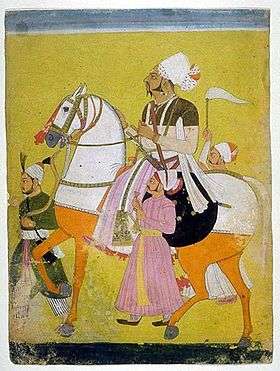Ratlam State
| Ratlam State रत्लाम रियासत | ||||||
| Princely State of British India | ||||||
| ||||||
| ||||||
 | ||||||
| History | ||||||
| • | Established | 1652 | ||||
| • | Independence of India | 1948 | ||||
| Area | ||||||
| • | 1901 | 1,795 km2 (693 sq mi) | ||||
| Population | ||||||
| • | 1901 | 83,773 | ||||
| Density | 46.7 /km2 (120.9 /sq mi) | |||||
| Today part of | Madhya Pradesh, India | |||||

.jpg)
Ratlam State[1] was a princely state in India, part of the Malwa Agency of Central India during the British Raj.
The state's capital was Ratlam town in modern Ratlam district of Madhya Pradesh. Ratlam was originally a huge state, but the then ruler Ratan Singh opposed Auranzeb in the Battle of Dharmatpur and was killed after a brave fight. The state was then reduced and the title of Maharaja was eventually stripped away; the title was later restored by the British during Maharaja Sajjan Singh's rule. On 5 January 1819 Ratlam State became a British protectorate.[2]
History
The state was founded in 1652. The first Ruler was Maharaja Ratan Singh who married 12 wives, among them Maharani Sukhroopde Kanwar Shekhawat Ji Sahiba, daughter of Kunwar Purshottam Das of Jhajhar (Shekhawati) in Rajasthan. She committed sati in 1658. Still shree ji maharaj natwar singh of ratlam from his family living in Jaipur. The State had an area of 1795 km2, which was closely interlaced with the territory of the princely State of Sailana. In 1901, the state had a population of 83,773; the town of Ratlam had a population of 36,321. The state enjoyed an estimated revenue of £34,000 and paid a tribute of £2,850. The town was a junction on the Rajputana-Malwa Railway, and was an important trade centre, especially of opium.[3]
Ratlam was initially held by its chiefs in vassalage to the Sindhia rulers of Gwalior State, but on 5 January 1819 it became a British protectorate, following which an arrangement was made by which the Sindhia engaged never to send any troops into the country or to interfere with the internal administration.[3] In 1861 the tribute was assigned to the British government in part as payment of the Gwalior contingent.[3]
The state's last ruler signed the instrument of accession to the Indian Union on 15 June 1948.
Rulers
The rulers belonged to the Ratanot Rathore line to which the rajas of Sailana State and Sitamau State also belonged.
Rajas
| Date of Reign | Rajas of Ratlam | Note |
|---|---|---|
| 1652–1658 | Ratan Singh (d.1658) | Biography
|
| 1695–1706 | Chhatrasal (d. 1712) | personal style Maharaja |
| 1706–Feb 1716 | Keshri Singh (d. 1716) |
He was killed and his throne was usurped by his younger brother Pratap Singh. |
| Feb 1716–1716 | Pratap Singh (d. 1716) |
He was killed by his nephew Jai Singh. |
| 1716–1743 | Man Singh (d. 1743) |
He divided his state with his younger brother Jai Singh, who became the first raja of Sailana State. |
| 1743–1773 | Prithvi Singh (d. 1773) | |
| 1773–1800 | Padam Singh (b. 17?? – d. 1800) | |
| 1800–1825 | Parbat Singh (d. 1825) | |
| 1825–29 Aug 1857 | Balwant Singh (b. 1814 – d. 1857) | |
| 1825–c.1832 | Borthwick | Regent |
| 29 Aug 1857 – 27 Jan 1864 | Bhairon Singh (b. 1839 – d. 1864) | |
| 27 Jan 1864 – 20 Jan 1893 | Ranjit Singh (b. 1860 – d. 1893) | from 15 Feb 1887, Sir Ranjit Singh |
| 27 Jan 1864 – 1 Jan 1880 | Khan Bahadur Mir Shahamat Ali | Regent |
| 20 Jan 1893 – 1 Jan 1921 | Sajjan Singh (b. 1880 – d. 1947) | |
| 20 Jan 1893 – 15 Dec 1898 | Khan Bahadur Cursetji Rustamji (b. 18?? – d. 1903) | Regent |
Maharajas
| Date of Reign | Maharajas of Ratlam |
|---|---|
| 1 Jan 1921 – 3 Feb 1947 | Sajjan Singh (s.a.) |
| 3 Feb 1947 – 15 Aug 1947 | Lokendra Singh (b. 1927 – d. 1991) |
| 1991 | Raja Raghuveer Singh |
See also
References
- ↑ Imperial Gazetteer of India, v. 21, p. 240.
- ↑ Princely States of India
- 1 2 3

External links

- Ratlam Search Engine

